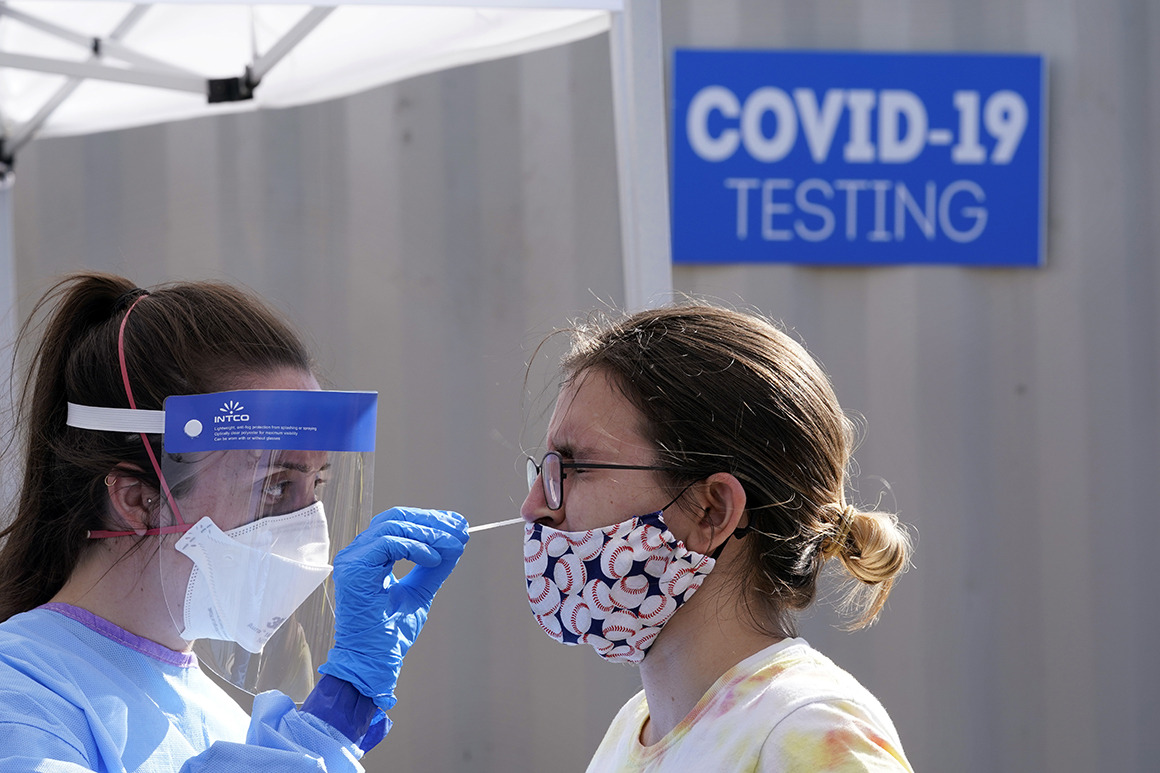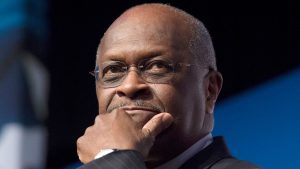WASHINGTON — Coronavirus infections are down in nearly every
state. That could either give President Donald Trump just what he
needs to prime his reelection odds or become another missed
opportunity to capitalize on a lull during the pandemic.
The positive trends are real. Covid-19 cases have been falling
since late July, including in several battleground states.
Hospitalizations have dropped 37 percent in the last month and the
daily death count is leveling off.
But that doesn’t mean the pandemic is over, even if Trump and
his team portray it that way.
The circumstances create a moment to reinforce public health
measures like testing, tracing and social distancing that could
finally bring the outbreak to more manageable proportions, while
the world waits for a vaccine or new treatments.
Trump hasn’t been inclined to go that route, instead pressing
states to reopen and slowing down testing. In his closing speech at
the Republican National Convention Thursday night. the president
said it was time for Americans to return to work and school,
and called on Democratic governors to open their states.
“We want them to be open,” Trump said. “They have to be
open. They have to get back to work. They have to get back to work,
and they have to get back to school.”
And holding the event on the White House’s South Lawn with a
boisterous crowd of about 1,500, only a few of whom were wearing
masks, signaled that the threat was over, it’s time to get on
with life.
Morgan Stanley projects at least 6.5 million U.S. infections by
October, and the University of Washington’s Institute for Health
Metrics and Evaluation on Thursday predicted
more than 260,000 people could be dead from the virus by
Election Day, a 44 percent increase from current levels.
Democrats are betting that even if the coronavirus’ toll on
the U.S. continues to decline, the perception of the president’s
handling of the virus is already baked, and that a message that
thousands of Americans needlessly died will resonate no matter the
infection level come November.
Daniel Smith, a political science professor at the University of
Florida, said his polls show that those who have concluded that the
president fumbled the response are unlikely to be swayed by a
couple of weeks’ worth of good numbers, particularly because
thousands are still being infected every day.
“It’s going to be tough for a lot of folks to slide back,”
he said. “We are still not out of the woods.”
Dave Wasserman, an editor at the Cook Political Report, said
there isn’t evidence yet of a Trump bounce related to Covid-19,
but that it’s still possible that voters will accept the pandemic’s
toll and that the issue will recede along with infection rates.
Trump and his Republican allies spent the past week looking
beyond the crisis, talking about it in the past tense and betting
that enough people are no longer shocked by grim death totals.
It’s a game plan that works best when the president stays
on-script, as he did Thursday night, and avoids detours —
suggesting that disinfectants or sunlight are cures, for example
— that can take over the news cycle.
Trump’s focus on schools also suggests that the White House
knows declining infection numbers aren’t enough.
All the surveys show people are still frustrated they can’t
return to their normal lives, said Robert Blendon, director of the
Harvard Opinion Research Program.
“He wouldn’t be fighting so hard to make the schools open if
he thought the [infection] numbers were enough,” he said.
“It’s very measurable in people’s lives. The president
can’t spin it.”
It’s a similar spot to where the president found himself in
the spring, when the average number of new daily infections dropped
to around 20,000 and Trump,
eager to declare victory, berated governors who refused to open
their economies. Vice President Mike Pence
dismissed the possibility of a boomerang effect — which is
exactly what happened when infections, hospitalizations and deaths
skyrocketed in July.
Irwin Redlener, director of the Pandemic Resource and Response
Initiative at Columbia University, said spending four days
pretending the virus was gone just repeated the mistakes of the
spring.
“They are being smug and opportunistic by giving a message
that they have this under control, which is very far from the
truth,” he said.
For now, the numbers are again breaking in the right direction.
The U.S. is averaging roughly 42,000 new infections per day, down
from 49,000 last week and 65,000 earlier this summer. The decline
has been particularly significant in states like Arizona and
Florida, two battlegrounds that could decide the election.
Even with the numbers looking better, Trump still has to
convince people it’s truly safe to venture out in order to get the
bounce he’s looking for — and fully rebut the charge that his
mishandling of the pandemic has sunk the economy and killed
Americans. That’s tough if local officials continue to limit the
size of family gatherings, keep bars closed and restrict travel.
Many businesses are still shuttered or having workers
telecommute.
A fatigued public remains especially sensitive to school
closings, as well as lockdowns of nursing homes, which keep them
separated from loved ones and prohibit gatherings like weddings and
big birthday parties. The staggering job losses and economic
devastation from the shutdowns have also served as regular
reminders that the nation hasn’t turned the corner.
“It has to recede enough that people’s lives change,”
Blendon said. “If the numbers just go down 8 percent and the
schools won’t open up and you’re still doing this from your
bedroom, it’s a completely different issue.”
The infection numbers also don’t always tell the whole story.
Recent testing rates have either plateaued or fallen, potentially
deflating the case totals. And the Trump administration ordered the
Centers for Disease Control and Prevention to stop promoting
Covid-19 testing for most people who have been exposed to the virus
but aren’t showing symptoms, which could further distort
reporting.
The temporary respite from the pandemic did change public
perceptions this week. A
CNBC/Change Research poll showed that in six swing states —
Arizona, Florida, Michigan, North Carolina, Pennsylvania and
Wisconsin — the share of respondents who said they have “very
serious” concerns about the coronavirus dropped to 45 percent
from 49 percent two weeks earlier.
The same poll found that opinions about Trump’s handling of
the response move in line with people’s sense of whether he is
ensuring schools can open safely.
Pence, during his acceptance speech at the Republican National
Convention, said the administration is “reopening America’s
schools.” Trump on Thursday painted Democratic nominee Joe Biden
as the candidate who would keep schools closed while saying that
his administration is “allowing lower-risk Americans to safely
return to work and school.”
But 61 percent of public K-12 schools plan to begin the year
virtually and another 18 percent are employing a hybrid model,
according to Dennis Roche, co-founder of the New York-based
Burbio.com, which aggregates school data.
And that’s a trend heading in the wrong direction, as more
schools every week announce they can’t accommodate a return to
the classroom.
It’s an issue that could have an outsize effect on suburban
women, who are expected to play a decisive role in the
election.
“If [students] can’t go back, who is going to watch the
kids,” Blendon said. “This issue is very practical.”
Meanwhile, a recent spate of outbreaks on college campuses has
sickened thousands of students and faculty, forcing them to
quarantine and make the last-minute switch to online learning.
The University of North Carolina at Chapel Hill was forced to
end in-person instruction for undergraduates just a week after
reopening, after dozens of students living in dorms and a
fraternity house tested positive for the coronavirus.
“There are a lot of frustrated parents,” said Mark
McClellan, who led the FDA for President George W. Bush and now
directs the Duke-Margolis Center for Health Policy. “They just
moved their kids into UNC and now they have to move them out
because we don’t have good enough control of the virus for
schools to reopen.”
Such uncertainty will factor heavily in the biggest swing state,
Florida, where new daily infections are hovering around 3,300, down
from almost 10,000 one month ago.
“If there is a real dip in Covid, it’s probably going to
help bring some of the wavering Republicans back into the fold for
Trump,” said Susan MacManus, a professor of political scientist
at the University of South Florida. “If it spikes, it’s just
the opposite.”
Florida Gov. Ron DeSantis, one of the president’s most
reliable allies, has been looking for ways to reopen nursing homes
and assisted living facilities and on Wednesday a task force his
administration put together recommended allowing face-to-face
visits. The recommendations would even allow visitors to enter
without first being tested, a move
criticized by AARP Florida.
That kind of return to normalcy — attending a wedding,
visiting a grandparent — is ultimately what will convince people
that the nation has turned the corner.
“The problem is people’s whole lives have been disrupted,”
Harvard’s Blendon said. “If the disruption is over, the incumbent
will claim credit. If it isn’t, the challenger has an advantage.
All you have to do is say, ‘I’ll do better.’”



















